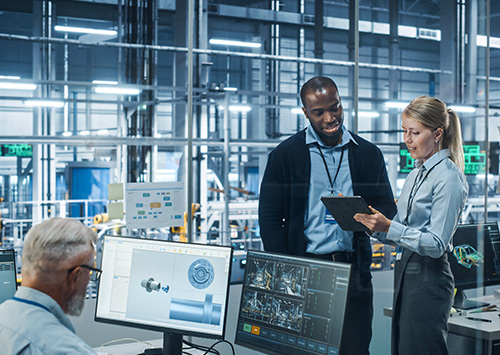- Services
Technology Capabilities
Technology Capabilities- Product Strategy & Experience DesignDefine software-driven value chains, create purposeful interactions, and develop new segments and offerings
- Digital Business TransformationAdvance your digital transformation journey.
- Intelligence EngineeringLeverage data and AI to transform products, operations, and outcomes.
- Software Product EngineeringCreate high-value products faster with AI-powered and human-driven engineering.
- Technology ModernizationTackle technology modernization with approaches that reduce risk and maximize impact.
- Embedded Engineering & IT/OT TransformationDevelop embedded software and hardware. Build IoT and IT/OT solutions.
- Industries
- GlobalLogic VelocityAI
- Insights
BlogsMarch 15, 2023GlobalLogicIf You Build Products, You Should Be Using Digital Twins
Digital twin technology is one of the fastest growing concepts of Industry 4.0. In the ...
 BlogsJanuary 25, 2023GlobalLogic
BlogsJanuary 25, 2023GlobalLogicDeploying a Landing Zone with AWS Control Tower – Part 3
In this post, we’re going to walkthrough some of the remaining post configuration tasks...
- About
Published on April 27, 2023Benefits of Total Experience (TX) Strategy in Modernizing Applications
View all articles Oleksandr BerezaArchitecture, Project ManagementShare
Oleksandr BerezaArchitecture, Project ManagementShareLet's start engineering impact together
GlobalLogic provides unique experience and expertise at the intersection of data, design, and engineering.
Get in touchCross-IndustryContributors:Anton Boretskyi – coordination
Oleksandr Bereza – contributor
Oleksandr Yevtushenko – reviewer
Harsimrat Singh – reviewer
The world is undergoing a rapid and dynamic transformation, with technological advancements taking center stage. Embracing modernization and implementing a Total Experience (TX) strategy can help companies stay ahead of the curve and gain a competitive edge while remaining agile and responsive to new opportunities.
Gartner predicts that by 2024, organizations providing a total experience will outperform competitors by 25% in satisfaction metrics for both customer experience (CX) and employee experience (EX). In this blog post, learn how to embrace modernization and revamp your products, applications, and solutions to stay ahead of the competition and drive revenue with a Total Experience strategy.
What is Total Experience (TX)?
As Gartner defined it, Total Experience “is a strategy that creates superior shared experiences by weaving together the four disciplines i.e., the multi-experience (MX), customer experience (CX), employee experience (EX) and user experience (UX).”
Multi Experience (MX)
The predecessor of the Multi Experience (MX) strategy was omnichannel, which combines a company’s multiple touch points – website, social, email, mobile, etc. – into a single approach based on information from various sources.
Multi-experience extended omnichannel by shifting the focus from channels and technology to thinking about how people will use an application and interact with the company or product. It aims to provide an optimal experience tailored to the individual customer or user, touchpoints, context, and interaction methods.
Customer Experience (CX)
The holistic perception of a product or brand is customer experience (CX). The total result of how end users interact with business: talk with the support team, order and buy something on the website. It’s essential to build the best customer experience for repeat sales. Loyalty to the brand, customer satisfaction, and positive recommendations could bring in new customers and generate sales.
Employee Experience (EX)
The Employee Experience (EX) evaluates employees’ journey stages: engaging, developing, and retaining. People are the most import and resource in most different business areas. A person who grows and feels comfortable in work could give the company more than expected. Loyalty and satisfaction can bring a new idea for a feature, product, or business.
Recommended reading: Improving Employee Experiences – A Playbook, from Method
User Experience (UX)
How the end user interacts with a product or application and how the system is flexible and understandable is what the User Experience (UX) is. UX is essential for all products or applications users and delivers the end user to the expected destination without additional help or explanation.
How Total Experience Impacts the Modernization Process
Application modernization is a process that improves the performance of business software delivery by upgrading rather than replacing older software systems. Modernization is not easy, but it can be a lighter, more affordable lift when we understand all needs before updating a product.
Applying the TX strategy to application modernization maximizes the value of the output for both customers and employees, providing users with more contact points and empowering employees with the tools they need to deliver intelligent customer service.
Here’s why each TX component – MX, CX, EX, and UX – matters in the context of a modernization process.
Why Multi-experience Matters in Modernization
Multiple touchpoints are essential for building a sales strategy for the individual user, and businesses should remember the MX method when updating an application. Use a technique for selecting technologies that suits the final goal; for example, cloud migration could open the door to new cloud features and give a new vision of Multi-experience.
Of course, modernization will add new MX features to the latest version of the product, increasing loyalty and customer and employee experience in general.
Why CX Matters in Modernization
CX is the most crucial factor of any modernization application process, as the customer is the epicenter of all products. External feedback is critical in furthering your understanding of how the product or application is used, and it’s essential to gather this before starting the modernization process. Modernization is more than updating a technology stack or migrating to a cloud infrastructure. The proper updates can significantly increase the number of new users and drive existing satisfaction. What’s more, CX can substantially decrease development time, increase customer satisfaction and loyalty, and fuel a successful product.
Why EX Matters in Modernization
Many companies invest a lot in CX but skip employees’ interests, and it’s a costly oversight. End users communicate with employees, and their feedback can inform new ideas. Employees are experienced product experts with valuable insight into pain points, challenges, and opportunities to improve the customer experience.
Why UX Matters in Modernization
Updates to the user interface must be considered and tested carefully, given the impact UX can have on customers and employees – and business results. Streaming for video calls, for example, requires new technology changes. Sometimes, this is a killer feature for a product, and it’s impossible to forget when modernizing the application. Other times, you might think a change in navigation or updating a button is inconsequential – until it has a significant impact.
Benefits of Applying a Total Experience Lens to Application Modernization
Upgrading legacy applications and products isn’t a one-and-done operation. Products become legacy the day after each subsequent release. The ongoing modernization process provides a framework for improving experiences and reaping benefits. Here are some examples.
Increasing Brand Loyalty
Total Experience is a powerful tool to increase brand loyalty when a business modernizes the application. Building brand loyalty requires over-delivery on expectations and is fueled by two-way client communications that focus on integrating feedback. A TX strategy helps further product recognition, satisfaction, and customer and employee feedback.
Reduced Business Silos
Segregated organizational cultures are common, and UX, CX, and EX representatives rarely collaborate on the same project simultaneously. Typically, the project moves from stage to stage without a cohesive understanding of the problems the previous Experience confronted or solved. In a TX strategy, various experiences work together seamlessly so that everyone can understand the needs of others and how their actions affect the overall product. This is crucial in the application modernization process, where getting to market faster with a superior product can mean a significant business win.
A Healthy, Stimulating Culture of Innovation
Moving a project from stage to stage without the input and perspective of all Experiences has another major drawback: it hampers innovation. Rather than having all types of professionals and their richly varied points of view pulling together in the same direction, they may only be aware of the task at hand. Taking a TX approach helps everyone involved understand the needs of others and how their actions affect the overall experience.
More Creative Product
Creative products result from innovative ideas that win enough support to become innovations. They must bring something new that serves a purpose and solves a problem in a new way. Fresh, creative ideas exist throughout the modernization process, but what features hold the most significant potential value for the business? Motivated employees (EX) can share new, exciting ideas, and pairing those with CX and UX insights can only strengthen the use case.
Increase the Speed of the Modernization Process
Taking a TX approach means each Experience team understands the needs and goals of the others. All parties agree on the required technologies and can work together to reduce the iteration count. With an overall view of who provides which inputs, when – and, importantly, why – teams can better budget their time and prepare for their next steps.
A Clear, Shared Final Product Vision
The collaboration process can result in more inputs than expected, but this combination of opinions and experiences drives a successful product. The key is clearly defining a vision for the product’s future and ensuring all teams have ongoing access to it. By its very nature, TX considers each of the Experiences and incorporates that into the product vision. When all can see the final picture, they understand each stakeholder’s steps to achieve the goal. The definition of each step could change a modernization process flow and significantly reduce time and costs.
Successful TX Strategy in Action: Modernization via Multi Experience for a Fast Food Brand
This theory is great, but what does it look like in practice? In the process of modernization application, the first step is to draw a picture of the system as it currently exists. The state of a system describes different people from a domain and other points of view. This analysis provides incredible results; often, modernization results in an entirely new product that will grow and evolve with the business for years to come.
That’s precisely how we approached a modernization request from McDonald’s, one of the world’s largest fast-food corporations. To meet consumers’ increasing expectations for self-service options, the restaurant brand needed a new system for order-taking.
Now, customers can browse the menu, place their order, and process payment without communicating any of this to a counter clerk. Those employees, in turn, are freed up to focus on other essential elements of the customer experience: cleaning the store’s interior and exterior, preparing and packaging orders with great accuracy, maintaining equipment, providing a comfortable dining room experience, etc.
Multi-experience brought a new device to the ordering process, and the modernized application offers an intuitive UX. More than ticking the boxes across the TX spectrum, this solution meets the needs of every type of stakeholder and the business as a whole.
Conclusion
Our current reality requires dynamic adaptation, and businesses must modernize legacy solutions. Applying a Total Experience strategy that weaves together four disciplines – multi-experience (MX), customer experience (CX), employee experience (EX), and user experience (UX) – allows us to do it most profitably.
TX can offer improved modernization process speed, internal and external brand loyalty, creative new solutions and features, reduced silos, and a healthier atmosphere of innovation across the company.
GlobalLogic has stayed at the forefront of the latest technology trends, strategies, and concepts for more than two decades. We apply best practices and TX lessons learned to each new application transformation process so that digital solutions can improve the consumer’s experience (CX), optimize operations (EX), and approach UX with a deep understanding of what each user needs.
Whether modernizing the solution involves AI and ML, virtual reality, IoT connectedness, mobile friendliness, or other technologies, our experience in high tech ensures we take an MX approach. This fuels more user touchpoints and a final product that will delight users and exceed their expectations.
Learn more:
